Convertendo imagens em PDF no Windows, Mac e Linux [um guia passo a passo]
índice
Instalar com Pip
pip install Spire.PDF
Links Relacionados
Você está procurando uma maneira simples e eficiente de converter imagens em PDF? Esteja você usando Windows, Mac ou Linux, este artigo irá ajudá-lo. Descubra os métodos passo a passo e as ferramentas úteis disponíveis em cada plataforma para transformar facilmente suas imagens em arquivos PDF com aparência profissional. De recursos integrados a aplicativos populares de terceiros, orientaremos você durante o processo, ajudando você a desbloquear o poder da conversão de imagem em PDF no sistema operacional de sua preferência.
- Converta imagens em PDF usando o conversor online gratuito
- Converta imagens em PDF no Windows
- Converta imagens em PDF no Mac
- Converta imagens em PDF no Linux
- Por que uma abordagem de programação é importante
- Converta imagens em PDF usando Python
Converta imagens em PDF usando o conversor online gratuito
Existem vários conversores online disponíveis para converter imagens em PDF, e o "melhor" pode variar dependendo das preferências pessoais e requisitos específicos. No entanto, posso recomendar Smallpdf como um conversor online popular e confiável para essa finalidade.
Smallpdf é um serviço baseado em nuvem que permite converter imagens em PDF a partir de praticamente qualquer dispositivo ou sistema operacional com conexão à Internet. Isso elimina a necessidade de instalação de software e permite conversões perfeitas em qualquer lugar.
Para converter imagens em PDF usando Samllpdf, siga estas etapas:
Passo 1. Insira e abra o seguinte URL em seu navegador: https://smallpdf.com/pdf-converter.

Passo 2. Clique em "ESCOLHER ARQUIVOS" e selecione um arquivo de imagem ou vários arquivos de imagem do dispositivo que você está usando. Se você clicar no botão suspenso ao lado de "ESCOLHER ARQUIVOS", terá a opção de carregar imagens do DropBox e do Google Drive.
Neste caso, selecionei quatro imagens de uma pasta no meu computador.
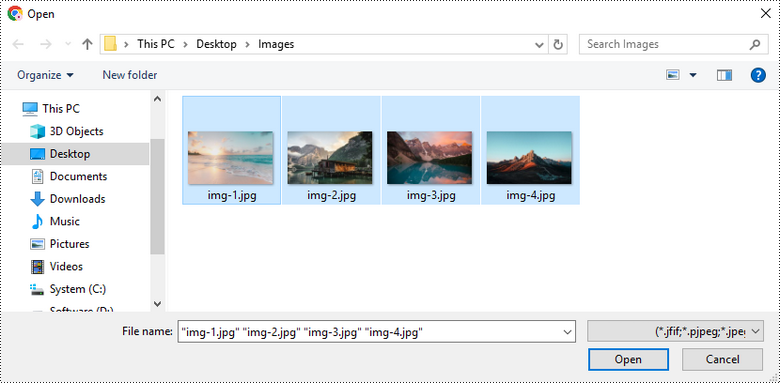
Passo 3. Personalize as configurações de conversão, como tamanho da página, orientação da página e margem. Em seguida, clique em "Converter" para iniciar o processo de conversão.
Esteja ciente de que os recursos "Sem Margem" e "Grande Margem" são exclusivos para usuários Pro. Para acessar esses recursos, você deve se registrar como membro. Como novo membro, você terá um período de teste gratuito de 7 dias para utilizar esses recursos sem nenhum custo.

Passo 4. Baixe o documento PDF gerado e salve-o em seu dispositivo.
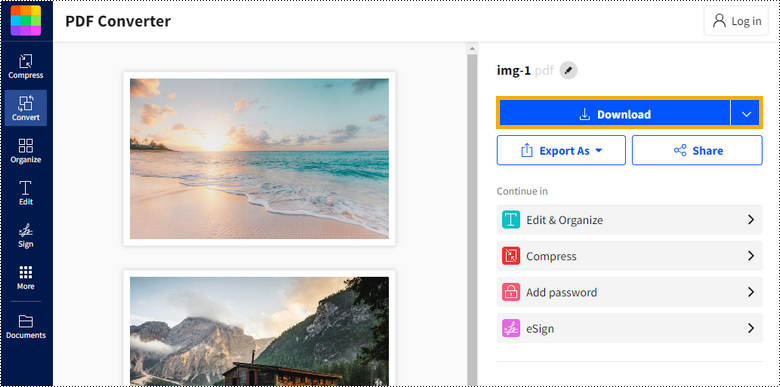
Converta imagens em PDF no Windows
Embora os conversores online ofereçam conveniência quando se trata de converter imagens em PDF, eles geralmente envolvem o upload de seus arquivos para a Internet, o que pode levantar preocupações sobre segurança e privacidade.
Felizmente, o Windows 10 ou 11 vem com Microsoft Print to PDF que permite aos usuários converter um número ilimitado de imagens em PDFs sem quaisquer limitações e custos.
O processo é o seguinte:
Passo 1. Abra a pasta onde seus arquivos de imagem estão armazenados.
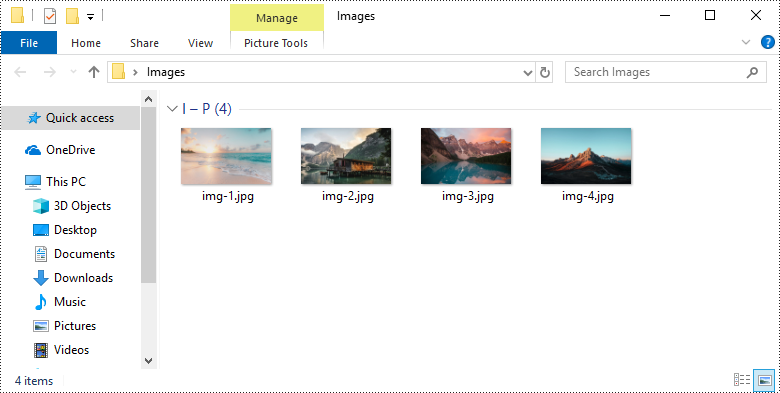
Passo 2. Selecione as imagens que você planeja converter para PDF. A ordem em que você seleciona essas imagens determinará sua sequência ao convertê-las para o formato PDF.
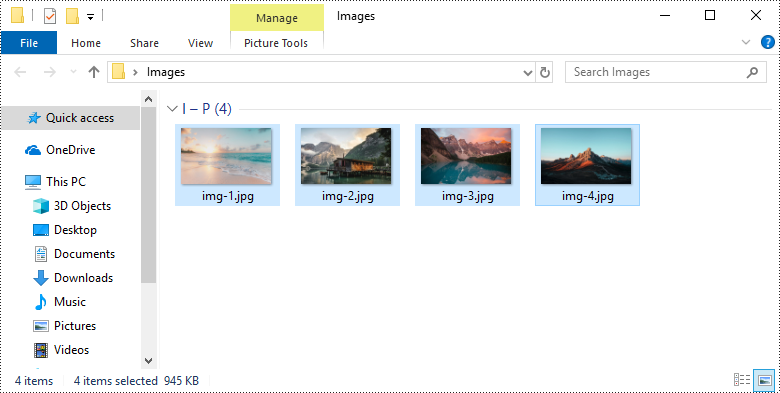
Passo 3. Clique com o botão direito nos arquivos e selecione Imprimir. Esta ação abrirá a janela Imprimir imagens.

Passo 4. Na caixa de diálogo Imprimir que aparece, selecione "Microsoft Print to PDF" como impressora. Ao mesmo tempo, você pode escolher o tamanho do papel, a orientação da página e a qualidade do arquivo PDF resultante. É aconselhável desmarcar a opção "Ajustar imagem ao quadro", pois isso pode cortar as bordas da imagem.

Passo 5. Clique no botão Imprimir no canto inferior direito da janela. Deverá aparecer uma janela que permite escolher onde o arquivo PDF será salvo.
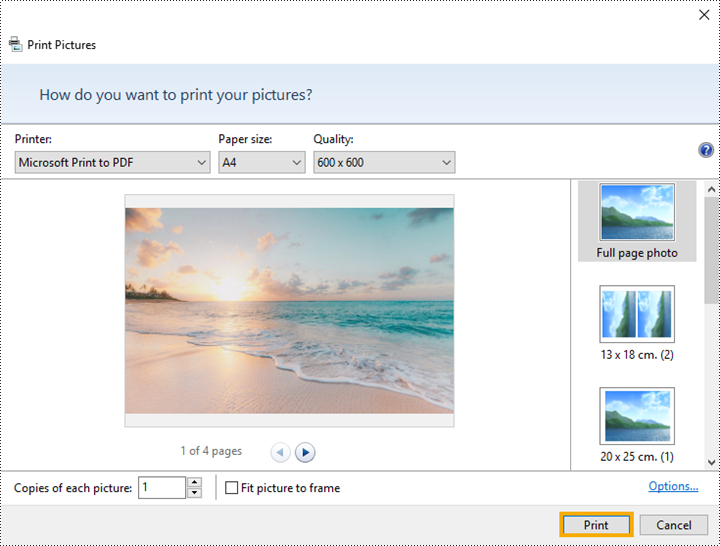
Passo 6. Navegue até o local de salvamento de sua preferência e forneça um nome para o arquivo PDF. Em seguida, clique em "Salvar".
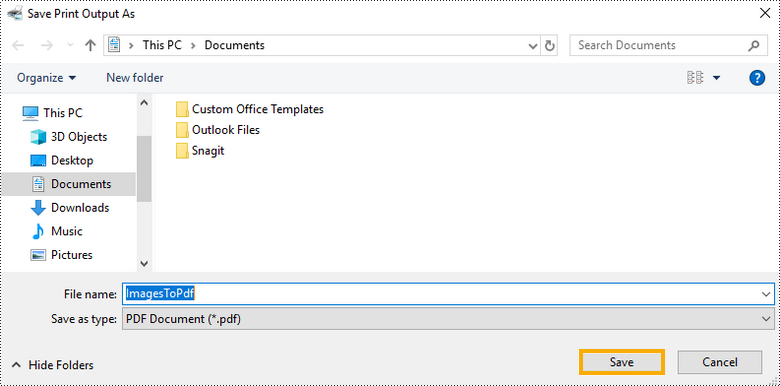
Converta imagens em PDF no Mac
No macOS, assim como no Windows 10 ou 11, você pode aproveitar um recurso integrado para converter imagens em formato PDF sem precisar de nenhum software extra.
Veja como você pode fazer isso:
Passo 1. Abra a pasta onde suas imagens estão armazenadas.
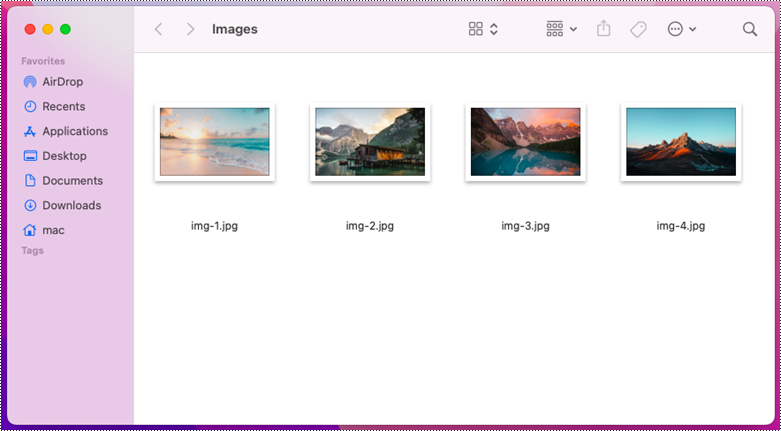
Passo 2. Selecione um ou vários arquivos de imagem que deseja converter em PDF. Clique com a tecla Control pressionada em um dos arquivos selecionados e escolha Ações rápidas > Criar PDF.
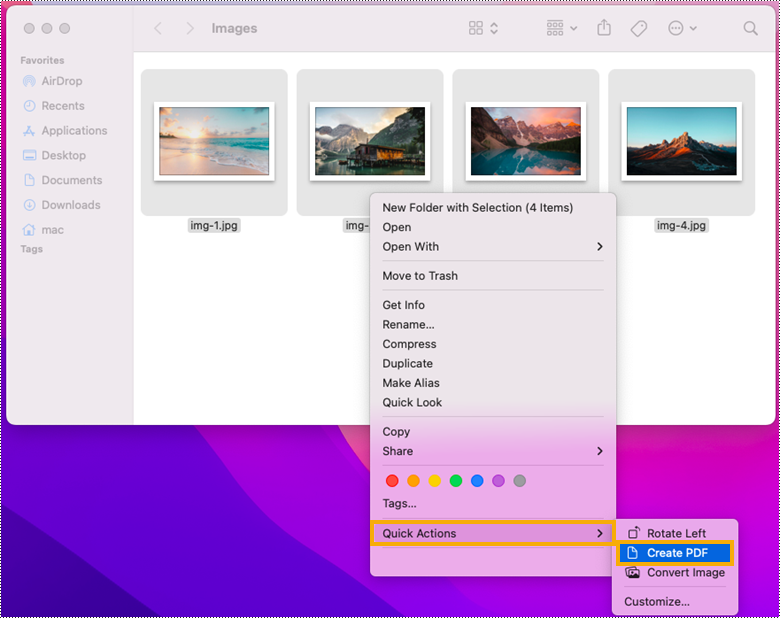
Passo 3. Encontre o PDF gerado na pasta onde você selecionou as imagens.
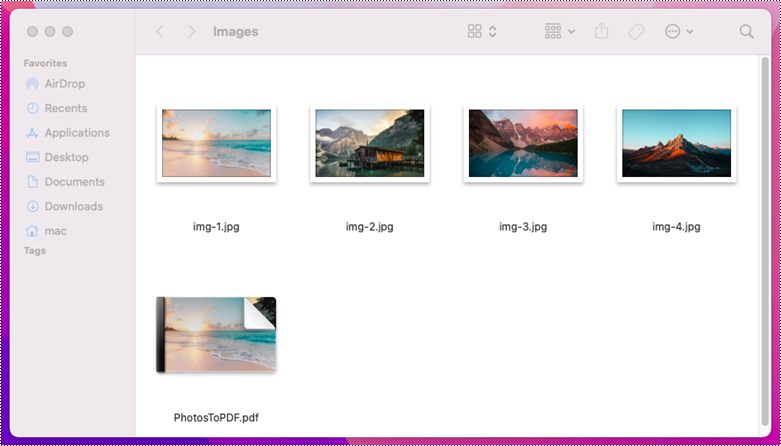
Converta imagens em PDF no Linux
O Linux não possui um recurso integrado especificamente dedicado à conversão de imagens para o formato PDF. No entanto, você pode usar software comprovado de terceiros como o ImageMagick , que é uma ferramenta gratuita e de código aberto usada para editar e manipular imagens digitais.
ImageMagick inclui uma interface de linha de comando para executar tarefas complexas de processamento de imagens. Ele é escrito em C e pode ser usado em vários sistemas operacionais, incluindo Linux, Windows e macOS.
Vamos mergulhar nos detalhes do processo de conversão.
Passo 1. Abra a pasta onde suas imagens estão armazenadas.
sudo apt install imagemagick # on Ubuntu sudo yum install ImageMagick # on CentOS sudo dnf install ImageMagick # on Fedora
Passo 2. Faça algumas alterações no arquivo policy.xml do ImageMagic para que você tenha permissão para manipular PDF. Você pode usar o editor de texto nano para ler o conteúdo de policy.xml. Aqui está o comando:
sudo nano /etc/ImageMagick-6/policy.xml
No texto exibido, role para baixo para encontrar esta linha:
<policy domain="coder" rights="none" pattern="PDF" />
Altere "none" para "read|write":
<policy domain="coder" rights="read|write" pattern="PDF" />
Passo 3. Navegue até a pasta onde suas imagens estão armazenadas.
cd /home/username/Desktop/Images
Passo 4: Converta as imagens da pasta em PDFs usando comandos.
Converta um arquivo de imagem em um documento PDF:
convert img-1.jpg image.pdf
Converta arquivos de imagem selecionados em um único documento PDF:
convert img-1.jpg img-2.jpg img-3.jpg CombineSelectedImages.pdf
Converta todas as imagens com extensões de arquivo especificadas em um documento PDF:
convert *.jpg *.png CombineAllImages.pdf
Por que uma abordagem de programação é importante
Embora existam muitas ferramentas e aplicativos on-line disponíveis para converter imagens em PDF, há vários motivos pelos quais você pode optar por implementar uma solução de programação:
- Personalização : Com a programação, você tem controle total sobre o processo de conversão. Você pode personalizar a conversão para atender a necessidades específicas, como definir tamanhos de página específicos, ajustar a qualidade da imagem ou adicionar metadados.
- Integração : se você estiver automatizando um fluxo de trabalho maior ou integrando a conversão em um aplicativo personalizado, criar scripts para seu próprio método de conversão permite uma integração perfeita com outros sistemas ou plataformas.
- Escalabilidade : As soluções de programação podem ser facilmente dimensionadas para lidar com grandes volumes de arquivos. Isto é particularmente útil em cenários de nível empresarial onde milhares de imagens precisam ser convertidas de forma eficiente.
- Automação : Ao escrever scripts ou programas, você pode automatizar todo o processo de conversão, incluindo tarefas de gerenciamento de arquivos antes e depois da conversão.
- Segurança : Ao trabalhar com dados confidenciais, ter controle sobre o processo de conversão dentro de um ambiente seguro pode impedir o acesso não autorizado às informações.
Converta imagens em PDF usando Python
Spire.PDF for Python, uma poderosa biblioteca Python para trabalhar com documentos PDF, permite aos programadores converter uma ampla variedade de formatos de imagem, incluindo JPG, PNG, BMP, GIF, EMF, SVG e TIFF, em documentos PDF de alta qualidade. Com suas ricas opções de personalização, os programadores podem adaptar facilmente os PDFs de saída para atender às suas especificações exclusivas.
Aqui está um exemplo de personalização de margens de página durante o processo de mesclagem de várias imagens bitmap em um único documento PDF usando Spire.PDF para Python:
- Python
from spire.pdf.common import *
from spire.pdf import *
import os
# Create a PdfDocument object
doc = PdfDocument()
# Set the left, top, right, bottom page margin
doc.PageSettings.SetMargins(10.0, 10.0, 10.0, 10.0)
# Get the folder where the images are stored
path = "C:\\Users\\Administrator\\Desktop\\Images\\"
files = os.listdir(path)
# Iterate through the files in the folder
for root, dirs, files in os.walk(path):
for file in files:
# Load a particular image
image = PdfImage.FromFile(os.path.join(root, file))
# Get the image width and height
width = image.PhysicalDimension.Width
height = image.PhysicalDimension.Height
# Specify page size
size = SizeF(width + doc.PageSettings.Margins.Left + doc.PageSettings.Margins.Right, height + doc.PageSettings.Margins.Top+ doc.PageSettings.Margins.Bottom)
# Add a page with the specified size
page = doc.Pages.Add(size)
# Draw image on the page at (0, 0)
page.Canvas.DrawImage(image, 0.0, 0.0, width, height)
# Save to file
doc.SaveToFile('output/CustomizeMargins.pdf')
doc.Dispose()
Para obter instruções mais detalhadas, verifique este link: Converter imagem em PDF com Python: 4 exemplos de código
Conclusão
Resumindo, a conversão de imagens em PDF pode ser feita por vários meios, desde recursos integrados em vários sistemas operacionais até software especializado de terceiros e até mesmo por meio de programação. Cada método oferece vantagens exclusivas em termos de facilidade de uso, funcionalidade e personalização. Quer você precise de uma conversão simples e única ou de uma solução sofisticada e automatizada, as opções discutidas fornecem uma base sólida para atender às suas necessidades de conversão de imagem em PDF.
Conversión de imágenes a PDF en Windows, Mac y Linux [Una guía paso a paso]
Tabla de contenido
Instalar con Pip
pip install Spire.PDF
enlaces relacionados
?Está buscando una forma sencilla y eficaz de convertir imágenes a PDF? Ya sea que esté utilizando Windows, Mac o Linux, este artículo lo cubre. Descubra los métodos paso a paso y las prácticas herramientas disponibles en cada plataforma para transformar sin esfuerzo sus imágenes en archivos PDF de aspecto profesional. Desde funciones integradas hasta aplicaciones populares de terceros, lo guiaremos a través del proceso y lo ayudaremos a desbloquear el poder de la conversión de imagen a PDF en el sistema operativo de su elección.
- Convierta imágenes a PDF usando el convertidor en línea gratuito
- Convertir imágenes a PDF en Windows
- Convertir imágenes a PDF en Mac
- Convertir imágenes a PDF en Linux
- Por qué es importante un enfoque de programación
- Convertir imágenes a PDF usando Python
Convierta imágenes a PDF usando el convertidor en línea gratuito
There are several online converters available for converting images to PDF, and the "best" one can vary depending on personal preferences and specific requirements. However, I can recommend Smallpdf as a popular and reliable online converter for this purpose.
Smallpdf es un servicio basado en la nube que le permite convertir imágenes a PDF desde prácticamente cualquier dispositivo o sistema operativo con conexión a Internet. Esto elimina la necesidad de instalar software y permite realizar conversiones fluidas sobre la marcha.
Para convertir imágenes a PDF usando Samllpdf, siga estos pasos:
Paso 1. Ingrese y abra la siguiente URL en su navegador web: https://smallpdf.com/pdf-converter.

Paso 2. Click "CHOOSE FILES" and select one image file or multiple image files from the device you're using. If you click on the drop-down button next to "CHOOSE FILES", you have the option to load images from DropBox and Google Drive.
En este caso, seleccioné cuatro imágenes de una carpeta en mi computadora.

Paso 3. Personalice la configuración de conversión, como el tamaño de página, la orientación de la página y el margen. A continuación, haga clic en "Convertir" para iniciar el proceso de conversión.
Tenga en cuenta que las funciones "Sin margen" y "Gran margen" son exclusivas para usuarios Pro. Para acceder a estas funciones, debe registrarse como miembro. Como miembro nuevo, tendrá un período de prueba gratuito de 7 días para utilizar estas funciones sin costo alguno.

Paso 4. Descargue el documento PDF generado y guárdelo en su dispositivo.

Convertir imágenes a PDF en Windows
Aunque los convertidores en línea ofrecen comodidad cuando se trata de convertir imágenes a PDF, a menudo implican cargar sus archivos a Internet, lo que puede generar preocupaciones sobre la seguridad y la privacidad.
Afortunadamente, Windows 10 u 11 viene con Microsoft Print to PDF que permite a los usuarios convertir un número ilimitado de imágenes a archivos PDF sin limitaciones ni costos.
El proceso es el siguiente:
Paso 1. Abra la carpeta donde están almacenados sus archivos de imagen.

Paso 2. Seleccione las imágenes que planea convertir a PDF. El orden en el que seleccione estas imágenes determinará su secuencia cuando las convierta al formato PDF.

Paso 3. Haga clic derecho en los archivos y luego seleccione Imprimir. Esta acción abrirá la ventana Imprimir imágenes.

Paso 4. En el cuadro de diálogo Imprimir que aparece, seleccione "Microsoft Print to PDF" como impresora. Al mismo tiempo, puedes elegir el tamaño del papel, la orientación de la página y la calidad del archivo PDF resultante. Es recomendable deseleccionar la opción "Ajustar imagen al marco", ya que puede recortar los bordes de la imagen.

Paso 5. Haga clic en el botón Imprimir en la esquina inferior derecha de la ventana. Debería aparecer una ventana que le permita elegir dónde se guardará el archivo PDF.

Paso 6. Navegue hasta su ubicación preferida para guardar y proporcione un nombre para el archivo PDF. Luego, haga clic en "Guardar".

Convertir imágenes a PDF en Mac
En macOS, al igual que en Windows 10 u 11, puedes aprovechar una función integrada para convertir imágenes a formato PDF sin necesidad de ningún software adicional.
Así es como puedes hacerlo:
Paso 1. Abre la carpeta donde están almacenadas tus imágenes.

Paso 2. Seleccione uno o varios archivos de imagen que desee convertir a PDF. Mantenga presionada la tecla Control y haga clic en uno de los archivos seleccionados, luego elija Acciones rápidas > Crear PDF.

Paso 3. Busque el PDF generado en la carpeta donde seleccionó las imágenes.

Convertir imágenes a PDF en Linux
Linux no tiene una función incorporada dedicada específicamente a convertir imágenes a formato PDF. Sin embargo, puede utilizar software de terceros probado como ImageMagick , que es una herramienta gratuita de código abierto que se utiliza para editar y manipular imágenes digitales.
ImageMagick incluye una interfaz de línea de comandos para ejecutar tareas complejas de procesamiento de imágenes. Está escrito en C y se puede utilizar en una variedad de sistemas operativos, incluidos Linux, Windows y macOS.
Profundicemos en los detalles del proceso de conversión.
Paso 1. Utilice uno de los siguientes comandos, según la distribución de Linux que esté utilizando, para instalar ImageMagick. Vale la pena se?alar que todos los comandos distinguen entre mayúsculas y minúsculas.
sudo apt install imagemagick # on Ubuntu sudo yum install ImageMagick # on CentOS sudo dnf install ImageMagick # on Fedora
Paso 2. Realice algunos cambios en el archivo Policy.xml de ImageMagic para que tenga permisos para manipular PDF. Puede utilizar el editor de texto nano para leer el contenido de Policy.xml. Aquí está el comando:
sudo nano /etc/ImageMagick-6/policy.xml
En el texto mostrado, desplácese hacia abajo para encontrar esta línea:
<policy domain="coder" rights="none" pattern="PDF" />
Cambie "ninguno" por "leer|escribir":
<policy domain="coder" rights="read|write" pattern="PDF" />
Paso 3. Navegue hasta la carpeta donde están almacenadas sus imágenes.
cd /home/username/Desktop/Images
Paso 4: convierta las imágenes de la carpeta a archivos PDF mediante comandos.
Convierta un archivo de imagen en un documento PDF:
convert img-1.jpg image.pdf
Convierta archivos de imagen seleccionados en un único documento PDF:
convert img-1.jpg img-2.jpg img-3.jpg CombineSelectedImages.pdf
Convierta todas las imágenes en extensiones de archivo específicas a un documento PDF:
convert *.jpg *.png CombineAllImages.pdf
Por qué es importante un enfoque de programación
Si bien existen muchas herramientas y aplicaciones en línea disponibles para convertir imágenes a PDF, existen varias razones por las que podría optar por implementar una solución de programación:
- Personalización : con la programación, tienes control total sobre el proceso de conversión. Puede adaptar la conversión para satisfacer necesidades específicas, como configurar tamaños de página particulares, ajustar la calidad de la imagen o agregar metadatos.
- Integración : si está automatizando un flujo de trabajo más grande o integrando la conversión en una aplicación personalizada, crear un script de su propio método de conversión permite una integración perfecta con otros sistemas o plataformas.
- Escalabilidad : las soluciones de programación se pueden escalar fácilmente para manejar grandes volúmenes de archivos. Esto es particularmente útil en escenarios de nivel empresarial donde es necesario convertir miles de imágenes de manera eficiente.
- Automatización : al escribir scripts o programas, puede automatizar todo el proceso de conversión, incluidas las tareas de administración de archivos antes y después de la conversión.
- Seguridad : cuando se trabaja con datos confidenciales, tener control sobre el proceso de conversión dentro de un entorno seguro puede evitar el acceso no autorizado a la información.
Convertir imágenes a PDF usando Python
Spire.PDF for Python, una potente biblioteca de Python para trabajar con documentos PDF, permite a los programadores convertir una amplia gama de formatos de imágenes, incluidos JPG, PNG, BMP, GIF, EMF, SVG y TIFF, en documentos PDF de alta calidad. Con sus ricas opciones de personalización, los programadores pueden adaptar sin esfuerzo los archivos PDF de salida para cumplir con sus especificaciones únicas.
A continuación se muestra un ejemplo de personalización de los márgenes de la página durante el proceso de combinación de varias imágenes de mapa de bits en un único documento PDF utilizando Spire.PDF for Python:
- Python
from spire.pdf.common import *
from spire.pdf import *
import os
# Create a PdfDocument object
doc = PdfDocument()
# Set the left, top, right, bottom page margin
doc.PageSettings.SetMargins(10.0, 10.0, 10.0, 10.0)
# Get the folder where the images are stored
path = "C:\\Users\\Administrator\\Desktop\\Images\\"
files = os.listdir(path)
# Iterate through the files in the folder
for root, dirs, files in os.walk(path):
for file in files:
# Load a particular image
image = PdfImage.FromFile(os.path.join(root, file))
# Get the image width and height
width = image.PhysicalDimension.Width
height = image.PhysicalDimension.Height
# Specify page size
size = SizeF(width + doc.PageSettings.Margins.Left + doc.PageSettings.Margins.Right, height + doc.PageSettings.Margins.Top+ doc.PageSettings.Margins.Bottom)
# Add a page with the specified size
page = doc.Pages.Add(size)
# Draw image on the page at (0, 0)
page.Canvas.DrawImage(image, 0.0, 0.0, width, height)
# Save to file
doc.SaveToFile('output/CustomizeMargins.pdf')
doc.Dispose()
Para obtener instrucciones más detalladas, consulte este enlace: Convertir imagen a PDF con Python: 4 ejemplos de código
Conclusión
En resumen, la conversión de imágenes a PDF se puede realizar a través de múltiples vías, que van desde funciones integradas en varios sistemas operativos hasta software especializado de terceros e incluso mediante programación. Cada método ofrece ventajas únicas en términos de facilidad de uso, funcionalidad y personalización. Ya sea que necesite una conversión simple y única o una solución sofisticada y automatizada, las opciones analizadas brindan una base sólida para satisfacer sus necesidades de conversión de imagen a PDF.
Conversione di immagini in PDF su Windows, Mac e Linux [Una guida passo passo]
Sommario
Installa con Pip
pip install Spire.PDF
Link correlati
Stai cercando un modo semplice ed efficace per convertire le immagini in PDF? Che tu utilizzi Windows, Mac o Linux, questo articolo ti copre. Scopri i metodi passo passo e gli strumenti pratici disponibili su ciascuna piattaforma per trasformare facilmente le tue immagini in file PDF dall'aspetto professionale. Dalle funzionalità integrate alle più diffuse applicazioni di terze parti, ti guideremo attraverso il processo, aiutandoti a sbloccare la potenza della conversione da immagini a PDF sul tuo sistema operativo preferito.
- Converti immagini in PDF utilizzando il convertitore online gratuito
- Converti immagini in PDF su Windows
- Converti immagini in PDF su Mac
- Converti immagini in PDF su Linux
- Perché è importante un approccio alla programmazione
- Converti immagini in PDF utilizzando Python
Convert Images to PDF using Free Online Converter
Sono disponibili diversi convertitori online per convertire le immagini in PDF e quello "migliore" può variare a seconda delle preferenze personali e dei requisiti specifici. Tuttavia, posso consigliare Smallpdf come convertitore online popolare e affidabile per questo scopo.
Smallpdf è un servizio basato su cloud che ti consente di convertire immagini in PDF praticamente da qualsiasi dispositivo o sistema operativo con una connessione Internet. Ciò elimina la necessità di installazione del software e consente conversioni senza interruzioni in movimento.
Per convertire le immagini in PDF utilizzando Samllpdf, attenersi alla seguente procedura:
Passaggio 1. Inserisci e apri il seguente URL nel tuo browser web: https://smallpdf.com/pdf-converter.

Passaggio 2. Fai clic su "SCEGLI FILE" e seleziona un file immagine o più file immagine dal dispositivo che stai utilizzando. Se fai clic sul pulsante a discesa accanto a "SCEGLI FILE", hai la possibilità di caricare immagini da DropBox e Google Drive.
In questo caso, ho selezionato quattro immagini da una cartella sul mio computer.

Passaggio 3. Personalizza le impostazioni di conversione, come dimensione della pagina, orientamento della pagina e margine. Successivamente, fai clic su "Converti" per avviare il processo di conversione.
Tieni presente che le funzionalità "Nessun margine" e "Grande margine" sono esclusive per gli utenti Pro. Per accedere a queste funzionalità è necessario registrarsi come membro. Come nuovo membro, avrai a disposizione un periodo di prova gratuito di 7 giorni per utilizzare queste funzionalità senza alcun costo.

Passaggio 4. Scarica il documento PDF generato e salvalo sul tuo dispositivo.

Convert Images to PDF on Windows
Sebbene i convertitori online offrano comodità quando si tratta di convertire immagini in PDF, spesso implicano il caricamento dei file su Internet, il che può sollevare preoccupazioni sulla sicurezza e sulla privacy.
Fortunatamente, Windows 10 o 11 viene fornito con Microsoft Print to PDF che consente agli utenti di convertire un numero illimitato di immagini in PDF senza limitazioni e costi.
Il processo è il seguente:
Passaggio 1. Apri la cartella in cui sono archiviati i file di immagine.

Passaggio 2. Seleziona le immagini che intendi convertire in PDF. L'ordine in cui selezioni queste immagini determinerà la loro sequenza quando le convertirai in formato PDF.

Passaggio 3. Fare clic con il pulsante destro del mouse sui file, quindi selezionare Stampa. Questa azione aprirà la finestra Stampa immagini.

Passaggio 4. Nella finestra di dialogo Stampa visualizzata, seleziona "Microsoft Print to PDF" come stampante. Allo stesso tempo, puoi scegliere il formato della carta, l'orientamento della pagina e la qualità del file PDF risultante. Si consiglia di deselezionare l'opzione "Adatta immagine alla cornice" poiché potrebbe ritagliare i bordi dell'immagine.

Passaggio 5. Fare clic sul pulsante Stampa nell'angolo in basso a destra della finestra. Dovrebbe apparire una finestra che ti consente di scegliere dove salvare il file PDF.

Passaggio 6. Passare alla posizione di salvataggio preferita e fornire un nome per il file PDF. Quindi, fare clic su "Salva".

Convert Images to PDF on Mac
Su macOS, proprio come su Windows 10 o 11, puoi sfruttare una funzionalità integrata per convertire le immagini in formato PDF senza bisogno di software aggiuntivo.
Ecco come puoi farlo:
Passaggio 1. Apri la cartella in cui sono archiviate le tue immagini.

Passaggio 2. Seleziona uno o più file immagine che desideri convertire in PDF. Fai clic tenendo premuto il tasto Ctrl su uno dei file selezionati, quindi scegli Azioni rapide > Crea PDF.

Passaggio 3. Trova il PDF generato nella cartella in cui hai selezionato le immagini.

Convert Images to PDF on Linux
Linux non dispone di una funzionalità integrata specificatamente dedicata alla conversione delle immagini in formato PDF. Tuttavia, puoi utilizzare software collaudati di terze parti come ImageMagick, che è un strumento gratuito e open source, utilizzato per modificare e manipolare immagini digitali.
ImageMagick include un'interfaccia a riga di comando per l'esecuzione di attività complesse di elaborazione delle immagini. è scritto in C e può essere utilizzato su una varietà di sistemi operativi, inclusi Linux, Windows e macOS.
Entriamo nei dettagli del processo di conversione.
Passaggio 1. Utilizza uno dei seguenti comandi a seconda della distribuzione Linux che stai utilizzando, per installare ImageMagick. Vale la pena notare che i comandi fanno tutti distinzione tra maiuscole e minuscole.
sudo apt install imagemagick # on Ubuntu sudo yum install ImageMagick # on CentOS sudo dnf install ImageMagick # on Fedora
Passaggio 2. Apporta alcune modifiche al file policy.xml di ImageMagic in modo da avere le autorizzazioni per manipolare PDF. È possibile utilizzare l'editor di testo nano per leggere il contenuto di policy.xml. Ecco il comando:
sudo nano /etc/ImageMagick-6/policy.xml
Nel testo visualizzato, scorri verso il basso per trovare questa riga:
<policy domain="coder" rights="none" pattern="PDF" />
Cambia "none" in "read|write":
<policy domain="coder" rights="read|write" pattern="PDF" />
Passaggio 3. Passare alla cartella in cui sono archiviate le immagini.
cd /home/username/Desktop/Images
Passaggio 4: converti le immagini nella cartella in PDF utilizzando i comandi.
Converti un file immagine in un documento PDF:
convert img-1.jpg image.pdf
Converti i file immagine selezionati in un singolo documento PDF:
convert img-1.jpg img-2.jpg img-3.jpg CombineSelectedImages.pdf
Converti tutte le immagini nelle estensioni di file specificate in un documento PDF:
convert *.jpg *.png CombineAllImages.pdf
Perché è importante un approccio alla programmazione
Sebbene siano disponibili molti strumenti e applicazioni online per convertire le immagini in PDF, ci sono diversi motivi per cui potresti scegliere di implementare una soluzione di programmazione:
- Personalizzazione : con la programmazione hai il pieno controllo sul processo di conversione. Puoi personalizzare la conversione per soddisfare esigenze specifiche, come l'impostazione di dimensioni di pagina particolari, la regolazione della qualità dell'immagine o l'aggiunta di metadati.
- Integrazione : se stai automatizzando un flusso di lavoro più ampio o integrando la conversione in un'applicazione personalizzata, lo scripting del tuo metodo di conversione consente un'integrazione perfetta con altri sistemi o piattaforme.
- Scalabilità : le soluzioni di programmazione possono essere facilmente scalate per gestire grandi volumi di file. Ciò è particolarmente utile negli scenari di livello aziendale in cui migliaia di immagini devono essere convertite in modo efficiente.
- Automazione : scrivendo script o programmi, puoi automatizzare l'intero processo di conversione, comprese le attività di gestione dei file prima e dopo la conversione.
- Sicurezza : quando si lavora con dati sensibili, avere il controllo sul processo di conversione all'interno di un ambiente sicuro può impedire l'accesso non autorizzato alle informazioni.
Converti immagini in PDF utilizzando Python
Spire.PDF for Python, una potente libreria Python per lavorare con documenti PDF, consente ai programmatori di convertire un'ampia gamma di formati di immagine, inclusi JPG, PNG, BMP, GIF, EMF, SVG e TIFF, in documenti PDF di alta qualità. Grazie alle sue ricche opzioni di personalizzazione, i programmatori possono personalizzare facilmente i PDF di output per soddisfare le loro specifiche uniche.
Ecco un esempio di personalizzazione dei margini della pagina durante il processo di unione di più immagini bitmap in un singolo documento PDF utilizzando Spire.PDF per Python:
- Python
from spire.pdf.common import *
from spire.pdf import *
import os
# Create a PdfDocument object
doc = PdfDocument()
# Set the left, top, right, bottom page margin
doc.PageSettings.SetMargins(10.0, 10.0, 10.0, 10.0)
# Get the folder where the images are stored
path = "C:\\Users\\Administrator\\Desktop\\Images\\"
files = os.listdir(path)
# Iterate through the files in the folder
for root, dirs, files in os.walk(path):
for file in files:
# Load a particular image
image = PdfImage.FromFile(os.path.join(root, file))
# Get the image width and height
width = image.PhysicalDimension.Width
height = image.PhysicalDimension.Height
# Specify page size
size = SizeF(width + doc.PageSettings.Margins.Left + doc.PageSettings.Margins.Right, height + doc.PageSettings.Margins.Top+ doc.PageSettings.Margins.Bottom)
# Add a page with the specified size
page = doc.Pages.Add(size)
# Draw image on the page at (0, 0)
page.Canvas.DrawImage(image, 0.0, 0.0, width, height)
# Save to file
doc.SaveToFile('output/CustomizeMargins.pdf')
doc.Dispose()
Per istruzioni più dettagliate, consulta questo collegamento: Converti immagine in PDF con Python: 4 esempi di codice
Conclusione
Per riassumere, la conversione delle immagini in PDF può essere effettuata attraverso molteplici strade, che vanno dalle funzionalità integrate su vari sistemi operativi a software specializzati di terze parti e persino attraverso la programmazione. Ciascun metodo offre vantaggi unici in termini di facilità d'uso, funzionalità e personalizzazione. Che tu abbia bisogno di una conversione semplice, una tantum o di una soluzione sofisticata e automatizzata, le opzioni discusse forniscono una solida base per soddisfare le tue esigenze di conversione da immagine a PDF.
Преобразование изображений в PDF в Windows, Mac и Linux [Пошаговое руководство]
Оглавление
Установить с помощью Пипа
pip install Spire.PDF
Ссылки по теме
Вы ищете простой и эффективный способ конвертировать изображения в PDF? Независимо от того, используете ли вы Windows, Mac или Linux, эта статья поможет вам. Откройте для себя пошаговые методы и удобные инструменты, доступные на каждой платформе, чтобы легко преобразовать ваши изображения в PDF-файлы профессионального качества. От встроенных функций до популярных сторонних приложений — мы проведем вас через весь процесс, помогая раскрыть возможности преобразования изображений в PDF в выбранной вами операционной системе.
- Конвертируйте изображения в PDF с помощью бесплатного онлайн-конвертера
- Конвертируйте изображения в PDF в Windows
- Конвертируйте изображения в PDF на Mac
- Конвертируйте изображения в PDF в Linux
- Почему важен подход к программированию
- Конвертируйте изображения в PDF с помощью Python
Конвертируйте изображения в PDF с помощью бесплатного онлайн-конвертера
Hay varios convertidores en línea disponibles para convertir imágenes a PDF, y el "mejor" puede variar según las preferencias personales y los requisitos específicos. Sin embargo, puedo recomendar Smallpdf как популярный и надежный онлайн-конвертер для этой цели.
Smallpdf — это облачный сервис, который позволяет конвертировать изображения в PDF практически с любого устройства или операционной системы с подключением к Интернету. Это устраняет необходимость установки программного обеспечения и обеспечивает плавное преобразование на ходу.
Чтобы преобразовать изображения в PDF с помощью Samllpdf, выполните следующие действия:
Шаг 1. Введите и откройте следующий URL-адрес в своем веб-браузере: https://smallpdf.com/pdf-converter.

Шаг 2. Нажмите "CHOOSE FILES" и выберите один или несколько файлов изображений на используемом вами устройстве. Если вы нажмете кнопку раскрывающегося списка рядом с надписью "CHOOSE FILES", у вас появится возможность загружать изображения из DropBox и Google Drive.
В данном случае я выбрал четыре изображения из папки на своем компьютере.

Шаг 3. Настройте параметры преобразования, такие как размер страницы, ориентация страницы и поля. Затем нажмите "Convert", чтобы начать процесс конвертации.
Обратите внимание, что функции "No Margin" и "Big Margin" доступны только пользователям Pro. Чтобы получить доступ к этим функциям, вам необходимо зарегистрироваться в качестве участника. Как новый участник, вы получите бесплатный 7-дневный пробный период, чтобы бесплатно использовать эти функции.

Шаг 4. Загрузите созданный PDF-документ и сохраните его на своем устройстве.

Конвертируйте изображения в PDF в Windows
Хотя онлайн-конвертеры удобны при преобразовании изображений в PDF, они часто требуют загрузки файлов в Интернет, что может вызвать опасения по поводу безопасности и конфиденциальности.
К счастью, Windows 10 или 11 поставляется с функцией Microsoft Print to PDF, которая позволяет пользователям конвертировать неограниченное количество изображений в PDF-файлы без каких-либо ограничений и затрат.
Процесс выглядит следующим образом:
Шаг 1. Откройте папку, в которой хранятся файлы изображений.

Шаг 2. Выберите изображения, которые вы планируете конвертировать в PDF. Порядок выбора этих изображений будет определять их последовательность при преобразовании их в формат PDF.

Шаг 3. Найдите сгенерированный PDF-файл в папке, в которой вы выбрали изображения.

Шаг 4. В появившемся диалоговом окне Печать выберите в качестве принтера "Microsoft Print to PDF". В то же время вы можете выбрать размер бумаги, ориентацию страницы и качество полученного PDF-файла. Рекомендуется снять флажок "Fit picture to frame", так как это может привести к обрезке краев изображения.

Шаг 5. Нажмите кнопку Печать в правом нижнем углу окна. Должно появиться окно, позволяющее выбрать место сохранения PDF-файла.

Шаг 6. Перейдите к предпочитаемому месту сохранения и укажите имя PDF-файла. Затем нажмите "Save".

Конвертируйте изображения в PDF на Mac
В macOS, как и в Windows 10 или 11, вы можете воспользоваться встроенной функцией для преобразования изображений в формат PDF без необходимости использования дополнительного программного обеспечения.
Вот как это можно сделать:
Шаг 1. Откройте папку, в которой хранятся ваши изображения.

Шаг 2. Выберите один или несколько файлов изображений, которые вы хотите преобразовать в PDF. Удерживая клавишу Control, нажмите один из выбранных файлов, затем выберите Быстрые действия > Создать PDF.

Шаг 3. Найдите сгенерированный PDF-файл в папке, в которой вы выбрали изображения.

Конвертируйте изображения в PDF в Linux
В Linux нет встроенной функции, специально предназначенной для преобразования изображений в формат PDF. Однако вы можете использовать проверенное стороннее программное обеспечение, например?ImageMagick, которое бесплатный инструмент с открытым исходным кодом, используемый для редактирования и управления цифровыми изображениями.
ImageMagick включает интерфейс командной строки для выполнения сложных задач обработки изображений. Он написан на языке C и может использоваться в различных операционных системах, включая Linux, Windows и macOS.
Давайте углубимся в детали процесса конвертации.
Шаг 1. Используйте одну из следующих команд в зависимости от используемого вами дистрибутива Linux, чтобы установить ImageMagick. Стоит отметить, что все команды чувствительны к регистру.
sudo apt install imagemagick # on Ubuntu sudo yum install ImageMagick # on CentOS sudo dnf install ImageMagick # on Fedora
Шаг 2. Внесите некоторые изменения в файл policy.xml ImageMagic, чтобы у вас были разрешения на управление PDF. Вы можете использовать текстовый редактор nano, чтобы прочитать содержимое policy.xml. Вот команда:
sudo nano /etc/ImageMagick-6/policy.xml
В отображаемом тексте прокрутите вниз, чтобы найти эту строку:
<policy domain="coder" rights="none" pattern="PDF" />
Измените "none" на "read|write":
<policy domain="coder" rights="read|write" pattern="PDF" />
Шаг 3. Перейдите в папку, в которой хранятся ваши изображения.
cd /home/username/Desktop/Images
Шаг 4. Преобразуйте изображения в папке в PDF-файлы с помощью команд.
Преобразуйте один файл изображения в документ PDF:
convert img-1.jpg image.pdf
Конвертируйте выбранные файлы изображений в один документ PDF:
convert img-1.jpg img-2.jpg img-3.jpg CombineSelectedImages.pdf
Конвертируйте все изображения с указанными расширениями файлов в документ PDF:
convert *.jpg *.png CombineAllImages.pdf
Почему важен подход к программированию
Хотя действительно существует множество онлайн-инструментов и приложений для преобразования изображений в PDF, есть несколько причин, по которым вы можете выбрать программное решение:
- Настройка : благодаря программированию вы получаете полный контроль над процессом преобразования. Вы можете настроить преобразование в соответствии с конкретными потребностями, например, установив определенные размеры страниц, отрегулировав качество изображения или добавив метаданные.
- Интеграция . Если вы автоматизируете более крупный рабочий процесс или интегрируете преобразование в собственное приложение, создание сценария собственного метода преобразования обеспечивает плавную интеграцию с другими системами или платформами.
- Масштабируемость : программные решения можно легко масштабировать для обработки больших объемов файлов. Это особенно полезно в сценариях корпоративного уровня, где необходимо эффективно преобразовать тысячи изображений.
- Автоматизация . Написав сценарии или программы, вы можете автоматизировать весь процесс преобразования, включая задачи управления файлами до и после преобразования.
- Безопасность : при работе с конфиденциальными данными контроль над процессом преобразования в безопасной среде может предотвратить несанкционированный доступ к информации.
Конвертируйте изображения в PDF с помощью Python
Spire.PDF for Python, мощная библиотека Python для работы с PDF-документами, позволяет программистам преобразовывать широкий спектр форматов изображений, включая JPG, PNG, BMP, GIF, EMF, SVG и TIFF, в высококачественные PDF-документы. Благодаря богатым возможностям настройки программисты могут легко адаптировать выходные PDF-файлы в соответствии со своими уникальными спецификациями.
Ниже приведен пример настройки полей страницы в процессе объединения нескольких растровых изображений в один PDF-документ с помощью Spire.PDF для Python:
- Python
from spire.pdf.common import *
from spire.pdf import *
import os
# Create a PdfDocument object
doc = PdfDocument()
# Set the left, top, right, bottom page margin
doc.PageSettings.SetMargins(10.0, 10.0, 10.0, 10.0)
# Get the folder where the images are stored
path = "C:\\Users\\Administrator\\Desktop\\Images\\"
files = os.listdir(path)
# Iterate through the files in the folder
for root, dirs, files in os.walk(path):
for file in files:
# Load a particular image
image = PdfImage.FromFile(os.path.join(root, file))
# Get the image width and height
width = image.PhysicalDimension.Width
height = image.PhysicalDimension.Height
# Specify page size
size = SizeF(width + doc.PageSettings.Margins.Left + doc.PageSettings.Margins.Right, height + doc.PageSettings.Margins.Top+ doc.PageSettings.Margins.Bottom)
# Add a page with the specified size
page = doc.Pages.Add(size)
# Draw image on the page at (0, 0)
page.Canvas.DrawImage(image, 0.0, 0.0, width, height)
# Save to file
doc.SaveToFile('output/CustomizeMargins.pdf')
doc.Dispose()
Для получения более подробных инструкций перейдите по этой ссылке: Преобразование изображения в PDF с помощью Python: 4 примера кода.
Заключение
Подводя итог, можно сказать, что преобразование изображений в PDF можно выполнить несколькими способами: от встроенных функций в различных операционных системах до специализированного стороннего программного обеспечения и даже посредством программирования. Каждый метод предлагает свои уникальные преимущества с точки зрения простоты использования, функциональности и настройки. Независимо от того, нужно ли вам простое однократное преобразование или сложное автоматизированное решение, обсуждаемые варианты обеспечат прочную основу для удовлетворения ваших потребностей в преобразовании изображений в PDF.
Windows, Mac 및 Linux 에서 이미지를 PDF 로 변환 [단계별 가이드]
목차
핍으로 설치
pip install Spire.PDF
관련된 링크들
이미지를 PDF 로 변환하는 간단하고 효율적인 방법을 찾고 계십니까? Windows, Mac, Linux 중 무엇을 사용하든 이 문서에서 다룹니다. 이미지를 전문가 수준의 PDF 파일로 쉽게 변환할 수 있도록 각 플랫폼에서 사용할 수 있는 단계별 방법과 편리한 도구를 알아보세요. 내장된 기능부터 널리 사용되는 타사 응용 프로그램에 이르기까지 프로세스를 안내하여 선택한 운영 체제에서 이미지를 PDF 로 변환하는 기능을 활용할 수 있도록 도와드립니다.
- 무료 온라인 변환기를 사용하여 이미지를 PDF 로 변환
- Windows 에서 이미지를 PDF 로 변환
- Mac 에서 이미지를 PDF 로 변환
- Linux 에서 이미지를 PDF로 변환
- 프로그래밍 접근 방식이 중요한 이유
- Python 을 사용하여 이미지를 PDF 로 변환
무료 온라인 변환기를 사용하여 이미지를 PDF 로 변환
이미지를 PDF 로 변환하는 데 사용할 수 있는 온라인 변환기는 여러 가지가 있으며, "best" 변환기는 개인 취향과 특정 요구 사항에 따라 달라질 수 있습니다. 하지만 저는 이러한 목적을 위한 인기 있고 신뢰할 수 있는 온라인 변환기로 Smallpdf 를 추천할 수 있습니다.
Smallpd f는 인터넷 연결이 가능한 거의 모든 장치나 운영 체제에서 이미지를 PDF 로 변환할 수 있는 클라우드 기반 서비스입니다. 이를 통해 소프트웨어를 설치할 필요가 없으며 이동 중에도 원활한 변환이 가능합니다.
Samllpdf 를 사용하여 이미지를 PDF로 변환하려면 다음 단계를 따르세요.
1 단계. 웹 브라우저에 다음 URL 을 입력하고 엽니다: https://smallpdf.com/pdf-converter .

2 단계. "CHOOSE FILES"을 클릭하고 사용 중인 장치에서 하나의 이미지 파일 또는 여러 개의 이미지 파일을 선택하세요. "CHOOSE FILES" 옆에 있는 드롭다운 버튼을 클릭하면 DropBox 및 Google Drive 에서 이미지를 로드할 수 있는 옵션이 제공됩니다.
이 경우에는 컴퓨터 폴더에서 4개의 이미지를 선택했습니다.

3 단계. 페이지 크기, 페이지 방향 및 여백과 같은 변환 설정을 사용자 정의합니다. 다음으로 "Convert"을 클릭하여 변환 프로세스를 시작하세요.
"No Margin" 및 "Big Margin" 기능은 Pro 사용자에게만 제공됩니다. 이러한 기능을 이용하려면 회원으로 등록해야 합니다. 신규 회원이 되시면 7일 무료 평가판 기간을 통해 이러한 기능을 무료로 활용하실 수 있습니다.


Windows 에서 이미지를 PDF 로 변환
온라인 변환기는 이미지를 PDF 로 변환할 때 편리함을 제공하지만 종종 파일을 인터넷에 업로드해야 하므로 보안 및 개인 정보 보호에 대한 우려가 발생할 수 있습니다.
다행히 Windows 10 또는 11 에는 Microsoft Print to PDF 가 포함되어 있어 사용자는 제한이나 비용 없이 무제한의 이미지를 PDF로 변환할 수 있습니다.
프로세스는 다음과 같습니다.
1 단계. 이미지 파일이 저장된 폴더를 엽니다.

2 단계. PDF 로 변환하려는 이미지를 선택하십시오. 이러한 이미지를 선택하는 순서에 따라 PDF 형식으로 변환할 때 이미지의 순서가 결정됩니다.

3 단계. 파일을 마우스 오른쪽 버튼으로 클릭한 다음 인쇄를 선택합니다. 이 작업을 수행하면 사진 인쇄 창이 열립니다.

4 단계. 나타나는 인쇄 대화 상자에서 프린터로 "Microsoft Print to PDF" 를 선택합니다. 동시에 결과 PDF 파일의 용지 크기, 페이지 방향 및 품질을 선택할 수 있습니다. 사진의 가장자리가 잘릴 수 있으므로 "사진을 프레임에 맞추기" 옵션을 선택 취소하는 것이 좋습니다.

5 단계. 창 오른쪽 하단에 있는 인쇄 버튼을 클릭하세요. PDF 파일을 저장할 위치를 선택할 수 있는 창이 나타납니다.

6 단계. 원하는 저장 위치로 이동하고 PDF 파일의 이름을 제공합니다. 그런 다음 "저장"을 클릭하세요.

Mac 에서 이미지를 PDF 로 변환
macOS 에서는 Windows 10 또는 11 과 마찬가지로 추가 소프트웨어 없이 이미지를 PDF 형식으로 변환하는 내장 기능을 활용할 수 있습니다.
방법은 다음과 같습니다.
1 단계. 이미지가 저장된 폴더를 엽니다.


3단계. 이미지를 선택한 폴더에서 생성된 PDF 를 찾으세요.

Linux 에서 이미지를 PDF 로 변환
Linux 에는 이미지를 PDF 형식으로 변환하는 전용 기능이 내장되어 있지 않습니다. 그러나 디지털 이미지를 편집하고 조작하는 데 사용되는 무료 오픈 소스 도구인 ImageMagick 과 같은 검증된 타사 소프트웨어를 사용할 수 있습니다 .
ImageMagick 에는 복잡한 이미지 처리 작업을 실행하기 위한 명령줄 인터페이스가 포함되어 있습니다. C로 작성되었으며 Linux, Windows 및 macOS 를 포함한 다양한 운영 체제에서 사용할 수 있습니다.
변환 프로세스의 세부 사항을 살펴보겠습니다.
1 단계. 사용 중인 Linux 배포판에 따라 다음 명령 중 하나를 사용하여 ImageMagick 을 설치합니다. 명령은 모두 대소문자를 구분한다는 점은 주목할 가치가 있습니다.
sudo apt install imagemagick # on Ubuntu sudo yum install ImageMagick # on CentOS sudo dnf install ImageMagick # on Fedora
sudo nano /etc/ImageMagick-6/policy.xml
표시된 텍스트에서 아래로 스크롤하여 다음 줄을 찾습니다.
<policy domain="coder" rights="none" pattern="PDF" />
"none"을 "read|write"로 변경합니다.
<policy domain="coder" rights="read|write" pattern="PDF" />
3 단계. 이미지가 저장된 폴더로 이동합니다.
cd /home/username/Desktop/Images
4 단계 : 명령을 사용하여 폴더의 이미지를 PDF로 변환합니다.
하나의 이미지 파일을 PDF 문서로 변환:
convert img-1.jpg image.pdf
선택한 이미지 파일을 단일 PDF 문서로 변환:
convert img-1.jpg img-2.jpg img-3.jpg CombineSelectedImages.pdf
지정된 파일 확장자의 모든 이미지를 PDF 문서로 변환:
convert *.jpg *.png CombineAllImages.pdf
프로그래밍 접근 방식이 중요한 이유
이미지를 PDF 로 변환하는 데 사용할 수 있는 온라인 도구와 응용 프로그램은 실제로 많지만 프로그래밍 솔루션 구현을 선택하는 데에는 몇 가지 이유가 있습니다:
- 사용자 정의 : 프로그래밍을 통해 변환 프로세스를 완벽하게 제어할 수 있습니다. 특정 페이지 크기 설정, 이미지 품질 조정, 메타데이터 추가 등 특정 요구 사항에 맞게 변환을 맞춤화할 수 있습니다.
- 통합 : 더 큰 작업 흐름을 자동화하거나 변환을 사용자 정의 애플리케이션에 통합하는 경우 자체 변환 방법을 스크립팅하면 다른 시스템 또는 플랫폼과 원활하게 통합할 수 있습니다.
- 확장성 : 프로그래밍 솔루션은 대용량 파일을 처리하기 위해 쉽게 확장될 수 있습니다. 이는 수천 개의 이미지를 효율적으로 변환해야 하는 기업 수준의 시나리오에서 특히 유용합니다.
- 자동화 : 스크립트나 프로그램을 작성하여 변환 전후의 파일 관리 작업을 포함한 전체 변환 프로세스를 자동화할 수 있습니다.
- 보안 : 중요한 데이터로 작업할 때 안전한 환경 내에서 변환 프로세스를 제어하면 정보에 대한 무단 액세스를 방지할 수 있습니다.
Python 을 사용하여 이미지를 PDF 로 변환
Spire.PDF for Python 프로그래머는 JPG, PNG, BMP, GIF, EMF, SVG 및 TIFF 를 포함한 광범위한 이미지 형식을 고품질 PDF 문서로 변환할 수 있습니다. 풍부한 사용자 정의 옵션을 통해 프로그래머는 고유한 사양에 맞게 출력 PDF를 쉽게 조정할 수 있습니다.
Spire.PDF for Python 사용하여 여러 비트맵 이미지를 단일 PDF 문서로 병합하는 과정에서 페이지 여백을 사용자 정의하는 예입니다.
- Python
from spire.pdf.common import *
from spire.pdf import *
import os
# Create a PdfDocument object
doc = PdfDocument()
# Set the left, top, right, bottom page margin
doc.PageSettings.SetMargins(10.0, 10.0, 10.0, 10.0)
# Get the folder where the images are stored
path = "C:\\Users\\Administrator\\Desktop\\Images\\"
files = os.listdir(path)
# Iterate through the files in the folder
for root, dirs, files in os.walk(path):
for file in files:
# Load a particular image
image = PdfImage.FromFile(os.path.join(root, file))
# Get the image width and height
width = image.PhysicalDimension.Width
height = image.PhysicalDimension.Height
# Specify page size
size = SizeF(width + doc.PageSettings.Margins.Left + doc.PageSettings.Margins.Right, height + doc.PageSettings.Margins.Top+ doc.PageSettings.Margins.Bottom)
# Add a page with the specified size
page = doc.Pages.Add(size)
# Draw image on the page at (0, 0)
page.Canvas.DrawImage(image, 0.0, 0.0, width, height)
# Save to file
doc.SaveToFile('output/CustomizeMargins.pdf')
doc.Dispose()
자세한 지침은 다음 링크를 확인하세요: Python 을 사용하여 이미지를 PDF 로 변환: 4 가지 코드 예제
결론
요약하자면, 이미지를 PDF 로 변환하는 작업은 다양한 운영 체제에 내장된 기능부터 전문적인 타사 소프트웨어, 심지어 프로그래밍까지 다양한 방법을 통해 수행할 수 있습니다. 각 방법은 사용 용이성, 기능 및 사용자 정의 측면에서 고유한 장점을 제공합니다. 간단한 일회성 변환이 필요하든, 정교하고 자동화된 솔루션이 필요하든, 논의된 옵션은 이미지를 PDF 로 변환하는 데 필요한 견고한 기반을 제공합니다.
Spire.XLS for Java 14.4.1 enhances the conversion from Excel to OFD
We're pleased to announce the release of Spire.XLS for Java 14.4.1. This version fixes the issues that the application threw an exception when converting Excel to OFD. More details are listed below.
Here is a list of changes made in this release
| Category | ID | Description |
| Bug | SPIREPDF-5187 | Fixes the issue that the application threw the "java.lang.IllegalArgumentException" exception when converting an Excel document to an OFD document. |
Spire.PDF 10.4.2 enhances the conversion from PDF to OFD and OFD to PDF
We are delighted to announce the release of Spire.PDF 10.4.2. This version enhances the conversion from PDF to OFD and OFD to PDF. Moreover, some known issues are fixed successfully in this version, such as the issue that text in vertically aligned format could not be highlighted. More details are listed below.
Here is a list of changes made in this release
| Category | ID | Description |
| Bug | SPIREPDF-3181 | Fixes the issue that text in vertically aligned format could not be highlighted. |
| Bug | SPIREPDF-6598 | Fixes the issue that the program did not report an error when using the PdfDocument.LoadFromFile(string filename) method to load a document with a password. |
| Bug | SPIREPDF-6611 | Fixes the issue that a dialog box prompting font problems popped up when using Adobe tools to open PDF documents converted from XPS documents. |
| Bug | SPIREPDF-6622 | Fixes the issue that invisible transparent text was displayed after converting a PDF document to an OFD document. |
| Bug | SPIREPDF-6623 | Fixes the issue that the program threw an exception System.ArgumentException when converting an OFD document to a PDF document. |
Converting Images to PDF on Windows, Mac, and Linux [A Step-by-Step Guide]
Table of Contents
Install with Pip
pip install Spire.PDF
Related Links
Are you looking for a simple and efficient way to convert images to PDF? Whether you're using Windows, Mac, or Linux, this article has got you covered. Discover the step-by-step methods and handy tools available on each platform to effortlessly transform your images into professional-looking PDF files. From built-in features to popular third-party applications, we'll guide you through the process, helping you unlock the power of image-to-PDF conversion on your operating system of choice.
- Convert Images to PDF using Free Online Converter
- Convert Images to PDF on Windows
- Convert Images to PDF on Mac
- Convert Images to PDF on Linux
- Why a Programming Approach Matters
- Convert Images to PDF using Python
Convert Images to PDF using Free Online Converter
There are several online converters available for converting images to PDF, and the "best" one can vary depending on personal preferences and specific requirements. However, I can recommend Smallpdf as a popular and reliable online converter for this purpose.
Smallpdf is a cloud-based service that enables you to convert images to PDF from virtually any device or operating system with an internet connection. This eliminates the need for software installation and allows for seamless conversions on the go.
To convert images to PDF using Samllpdf, follow these steps:
Step 1. Enter and open the following URL in your web browser: https://smallpdf.com/pdf-converter.

Step 2. Click "CHOOSE FILES" and select one image file or multiple image files from the device you're using. If you click on the drop-down button next to "CHOOSE FILES", you have the option to load images from DropBox and Google Drive.
In this case, I selected four images from a folder on my computer.

Step 3. Customize the conversion settings, such as page size, page orientation and margin. Next, click "Convert" to initiate the conversion process.
Kindly be aware that the "No Margin" and "Big Margin" features are exclusive to Pro users. To access these features, you are required to register as a member. As a new member, you will have a complimentary 7-day trial period to utilize these features at no cost.

Step 4. Download the generated PDF document and save it to your device.

Convert Images to PDF on Windows
Although online converters offer convenience when it comes to converting images to PDF, they often involve uploading your files to the internet, which can raise concerns about security and privacy.
Fortunately, windows 10 or 11 comes with Microsoft Print to PDF which enables users to convert unlimited number of images to PDFs without any limitations and costs.
The process is as follows:
Step 1. Open the folder where your image files are stored.

Step 2. Select the images you plan to convert to PDF. The order in which you select these images will determine their sequence when you convert them to PDF format.

Step 3. Right-click the files, then select Print. This action will open the Print Pictures window.

Step 4. In the Print dialog box that appears, select "Microsoft Print to PDF" as the printer. At the same time, you can choose the paper size, page orientation, and quality of the resulting PDF file. It is advisable to deselect the option "Fit picture to frame" as it may crop the edges of your picture.

Step 5. Click the Print button at the bottom-right corner of the window. A window that lets you choose where the PDF file will be saved should appear.

Step 6. Navigate to your preferred save location and provide a name for the PDF file. Then, click "Save".

Convert Images to PDF on Mac
On macOS, just like on Windows 10 or 11, you can take advantage of a built-in feature to convert images into PDF format without needing any extra software.
Here's how you can do it:
Step 1. Open the folder where your images are stored.

Step 2. Select one or multiple image files you want to convert into a PDF. Control-click one of the selected files, then choose Quick Actions > Create PDF.

Step 3. Find the generated PDF in the folder where you selected the images.

Convert Images to PDF on Linux
Linux does not have a built-in feature specifically dedicated to converting images to PDF format. However, you can use proven third-party software like ImageMagick, which is a free, open-source tool, used for editing and manipulating digital images.
ImageMagick includes a command-line interface for executing complex image processing tasks. It is written in C and can be used on a variety of operating systems, including Linux, Windows, and macOS.
Let's dive into the details of the conversion process.
Step 1. Use one of the following commands depending on the Linux distribution that you're using, to install ImageMagick. It is worth noting that the commands are all case-sensitive.
sudo apt install imagemagick # on Ubuntu sudo yum install ImageMagick # on CentOS sudo dnf install ImageMagick # on Fedora
Step 2. Make some changes in the policy.xml file of the ImageMagic so that you have the permissions to manipulate PDF. You can use the nano text editor to read the content of policy.xml. Here is the command:
sudo nano /etc/ImageMagick-6/policy.xml
In the displayed text, scroll down to find this line:
<policy domain="coder" rights="none" pattern="PDF" />
Change "none" to "read|write":
<policy domain="coder" rights="read|write" pattern="PDF" />
Step 3. Navigate to the folder where your images are stored.
cd /home/username/Desktop/Images
Step 4: Convert the images in the folder to PDFs using commands.
Convert one image file to a PDF document:
convert img-1.jpg image.pdf
Convert selected image files to a single PDF document:
convert img-1.jpg img-2.jpg img-3.jpg CombineSelectedImages.pdf
Convert all images in specified file extensions to a PDF document:
convert *.jpg *.png CombineAllImages.pdf
Why a Programming Approach Matters
While there are indeed many online tools and applications available for converting images to PDF, there are several reasons why you might choose to implement a programming solution:
- Customization: With programming, you have full control over the conversion process. You can tailor the conversion to meet specific needs, such as setting particular page sizes, adjusting image quality, or adding metadata.
- Integration: If you're automating a larger workflow or integrating the conversion into a custom application, scripting your own conversion method allows for a seamless integration with other systems or platforms.
- Scalability: Programming solutions can be easily scaled to handle large volumes of files. This is particularly useful in enterprise-level scenarios where thousands of images need to be converted efficiently.
- Automation: By writing scripts or programs, you can automate the entire conversion process, including file management tasks before and after the conversion.
- Security: When working with sensitive data, having control over the conversion process within a secure environment can prevent unauthorized access to information.
Convert Images to PDF using Python
Spire.PDF for Python, a powerful Python library for working with PDF documents, allows programmers to convert a wide range of image formats, including JPG, PNG, BMP, GIF, EMF, SVG, and TIFF, to high-quality PDF documents. With its rich customization options, programmers can effortlessly tailor the output PDFs to meet their unique specifications.
Here's an example of customizing page margins during the merge process of multiple bitmap images into a single PDF document using Spire.PDF for Python:
- Python
from spire.pdf.common import *
from spire.pdf import *
import os
# Create a PdfDocument object
doc = PdfDocument()
# Set the left, top, right, bottom page margin
doc.PageSettings.SetMargins(10.0, 10.0, 10.0, 10.0)
# Get the folder where the images are stored
path = "C:\\Users\\Administrator\\Desktop\\Images\\"
files = os.listdir(path)
# Iterate through the files in the folder
for root, dirs, files in os.walk(path):
for file in files:
# Load a particular image
image = PdfImage.FromFile(os.path.join(root, file))
# Get the image width and height
width = image.PhysicalDimension.Width
height = image.PhysicalDimension.Height
# Specify page size
size = SizeF(width + doc.PageSettings.Margins.Left + doc.PageSettings.Margins.Right, height + doc.PageSettings.Margins.Top+ doc.PageSettings.Margins.Bottom)
# Add a page with the specified size
page = doc.Pages.Add(size)
# Draw image on the page at (0, 0)
page.Canvas.DrawImage(image, 0.0, 0.0, width, height)
# Save to file
doc.SaveToFile('output/CustomizeMargins.pdf')
doc.Dispose()
For more detailed instructions, check this link out: Convert Image to PDF with Python: 4 Code Examples
Conclusion
To summarize, converting images to PDF can be done through multiple avenues, ranging from built-in features on various operating systems to specialized third-party software and even through programming. Each method offers its unique advantages in terms of ease of use, functionality, and customization. Whether you need a simple, one-time conversion or a sophisticated, automated solution, the options discussed provide a solid foundation for meeting your image-to-PDF conversion needs.
Python: Align Text in Word
Text alignment in Word refers to the way text is aligned along the horizontal axis of the page. Proper text alignment can significantly affect the overall appearance and aesthetics of a document, making it more engaging for readers. There are several types of text alignment available in Word:
- Left Alignment: Text is aligned along the left margin.
- Center Alignment: Text is centered between the left and right margins.
- Right Alignment: Text is aligned along the right margin.
- Justified Alignment: Text is aligned along both the left and right margins.
- Distributed Alignment: Text is evenly distributed between the left and right margins.
In this article, you will learn how to set different text alignments for paragraphs in Word in Python using Spire.Doc for Python.
Install Spire.Doc for Python
This scenario requires Spire.Doc for Python and plum-dispatch v1.7.4. They can be easily installed in your Windows through the following pip commands.
pip install Spire.Doc
If you are unsure how to install, please refer to this tutorial: How to Install Spire.Doc for Python on Windows
Align Text in Word in Python
With Spire.Doc for Python, you can get the paragraph formatting through the Paragraph.Format property, and then use the HorizontalAlignment property of the ParagraphFormat class to align text left/ right, center text, justify text, or distribute text in Word paragraphs. The following are the detailed steps:
- Create a Document instance.
- Add a section to the document using Document.AddSection() method.
- Add a paragraph to the section using Section.AddParagraph() method, and then append text to the paragraph.
- Get the paragraph formatting using Paragraph.Format property.
- Set left/center/right/justified/distributed text alignment for the paragraph using ParagraphFormat.HorizontalAlignment property.
- Save the result document using Document.SaveToFile() method.
- Python
from spire.doc import *
from spire.doc.common import *
# Create a Document instance
document = Document()
# Add a section
sec = document.AddSection()
# Add a paragraph and make it left-aligned
para = sec.AddParagraph()
para.AppendText("This paragraph is left-aligned.")
para.Format.HorizontalAlignment = HorizontalAlignment.Left
# Add a paragraph and make it centered
para = sec.AddParagraph()
para.AppendText("This paragraph is centered.")
para.Format.HorizontalAlignment = HorizontalAlignment.Center
# Add a paragraph and make it right-aligned
para = sec.AddParagraph()
para.AppendText("This paragraph is right-aligned.")
para.Format.HorizontalAlignment = HorizontalAlignment.Right
# Add a paragraph and make it justified
para = sec.AddParagraph()
para.AppendText("This paragraph is justified.")
para.Format.HorizontalAlignment = HorizontalAlignment.Justify
# Add a paragraph and make it distributed
para = sec.AddParagraph()
para.AppendText("This paragraph is distributed.")
para.Format.HorizontalAlignment = HorizontalAlignment.Distribute
# Save the result file
document.SaveToFile("AlignText.docx", FileFormat.Docx)
document.Close()
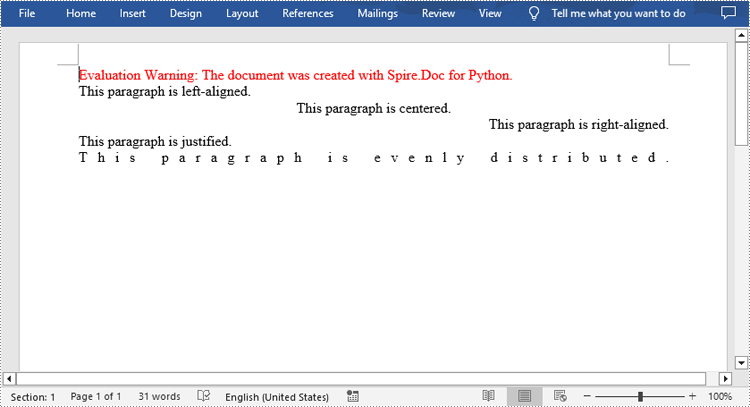
Apply for a Temporary License
If you'd like to remove the evaluation message from the generated documents, or to get rid of the function limitations, please request a 30-day trial license for yourself.
C#: Convert Markdown to Word and PDF
Markdown, as a lightweight markup language, is favored by programmers and technical document writers for its simplicity, readability, and clear syntax. However, in specific scenarios, there is often a need to convert Markdown documents into Word documents with rich formatting capabilities and control over the layout or to generate PDF files suitable for printing and easy viewing. This article is going to demonstrate how to convert Markdown content into Word documents or PDF files with Spire.Doc for .NET to meet various document processing requirements in different scenarios.
Install Spire.Doc for .NET
To begin with, you need to add the DLL files included in the Spire.Doc for.NET package as references in your .NET project. The DLL files can be either downloaded from this link or installed via NuGet.
PM> Install-Package Spire.Doc
Convert Markdown Files to Word Documents with C#
With Spire.Doc for .NET, we can load a Markdown file using Document.LoadFromFile(string fileName, FileFormat.Markdown) method and then convert it to other formats using Document.SaveToFile(string fileName, fileFormat FileFormat) method.
Since images in Markdown files are stored as links, directly converting a Markdown file to a Word document is suitable for Markdown files that do not contain images. If the file contains images, further processing of the images is required after conversion.
Here are the steps to convert a Markdown file to a Word document:
- Create an instance of Document class.
- Load a Markdown file using Document.LoadFromFile(string fileName, FileFormat.Markdown) method.
- Convert the file to a Word document and save it using Document.SaveToFile(string fileName, FileFormat.Docx) method.
- C#
using Spire.Doc;
namespace MdToDocx
{
class Program
{
static void Main(string[] args)
{
// Create an object of Document class
Document doc = new Document();
// Load a Markdown file
doc.LoadFromFile("Sample.md", FileFormat.Markdown);
// Convert the Markdown file to a Word document
doc.SaveToFile("MarkdownToWord.docx", FileFormat.Docx);
doc.Close();
}
}
}
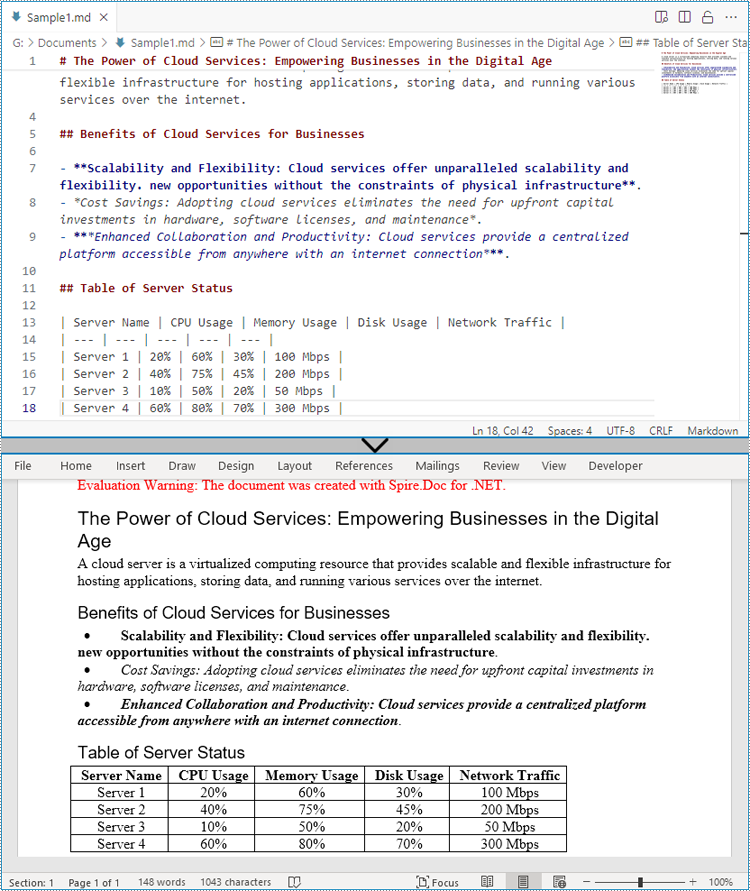
Convert Markdown Files to PDF Files with C#
We can also directly convert Markdown files to PDF files by using the FileFormat.PDF Enum as the parameter. Here are the steps to convert a Markdown file to a PDF file:
- Create an instance of Document class.
- Load a Markdown file using Document.LoadFromFile(string fileName, FileFormat.Markdown) method.
- Convert the file to a PDF file and save it using Document.SaveToFile(string fileName, FileFormat.Docx) method.
- C#
using Spire.Doc;
namespace MdToDocx
{
class Program
{
static void Main(string[] args)
{
// Create an object of Document class
Document doc = new Document();
// Load a Markdown file
doc.LoadFromFile("Sample.md", FileFormat.Markdown);
// Convert the Markdown file to a PDF file
doc.SaveToFile("MarkdownToPDF.pdf", FileFormat.PDF);
doc.Close();
}
}
}

Apply for a Temporary License
If you'd like to remove the evaluation message from the generated documents, or to get rid of the function limitations, please request a 30-day trial license for yourself.